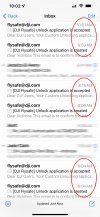In controlled airspace where the facility grid states an altitude limit of zero, what has been your experience when requesting manual authorization?
Around Boston as a Part-107 pilot, a LAANC response that denies authorization is typically unclear the reason for denying it. Once upon a time, I did receive a response that suggested the requested altitude was too high and I should aim lower. (I thought that was mostly absurd because the nearby buildings were taller than my requested altitude.) But that's probably the only time I was given a specific reason; since then I just assume the mostly likely reason is altitude.
For a commercial real estate job, the building is 40ft high; my request with ceiling of 100ft was rejected. Seeking to re-submit with a ceiling of 75ft, the Aloft app doesn't have an option between 50ft and 100ft. And 50 is not adequate.
This morning, I submitted another request at 75ft. But the Aloft app does not support that; I can specify 50 or 100, but not 75. To do this, I considered using B4UFly but I expect that to be exactly the same as the Aloft app. I began a request via DroneZone, but that clearly told me to use LAANC instead. So, although Airmap ceased functioning last year, I reinstalled that and it appeared to submit my request successfully.
In addition to the 75ft bit, there possibly might be another reason to use Airmap. When submitting LAANC request via the AirMap app, there's a text box where I can give a bit a brief statement about the flight safety, but the Aloft app does not have that. I have no idea if the FAA sees that or cares about it. (Some may complain about Airmap political wranglings, but achieving authorization is vastly more important.)
What I need is submit a request like this: The property height is X feet tall (or nearby trees are X feet tall) and I am requesting altitude X+50.
Around Boston as a Part-107 pilot, a LAANC response that denies authorization is typically unclear the reason for denying it. Once upon a time, I did receive a response that suggested the requested altitude was too high and I should aim lower. (I thought that was mostly absurd because the nearby buildings were taller than my requested altitude.) But that's probably the only time I was given a specific reason; since then I just assume the mostly likely reason is altitude.
For a commercial real estate job, the building is 40ft high; my request with ceiling of 100ft was rejected. Seeking to re-submit with a ceiling of 75ft, the Aloft app doesn't have an option between 50ft and 100ft. And 50 is not adequate.
This morning, I submitted another request at 75ft. But the Aloft app does not support that; I can specify 50 or 100, but not 75. To do this, I considered using B4UFly but I expect that to be exactly the same as the Aloft app. I began a request via DroneZone, but that clearly told me to use LAANC instead. So, although Airmap ceased functioning last year, I reinstalled that and it appeared to submit my request successfully.
In addition to the 75ft bit, there possibly might be another reason to use Airmap. When submitting LAANC request via the AirMap app, there's a text box where I can give a bit a brief statement about the flight safety, but the Aloft app does not have that. I have no idea if the FAA sees that or cares about it. (Some may complain about Airmap political wranglings, but achieving authorization is vastly more important.)
What I need is submit a request like this: The property height is X feet tall (or nearby trees are X feet tall) and I am requesting altitude X+50.












